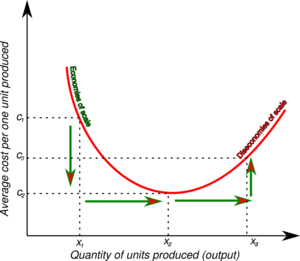Economies of scale
Economies of scale in microeconomics shows decreases of unit cost of production relative to the size of the production, at the same time it indicates the benefits of mass production. Increase in the volume of production (scale of production) decrease the long-term average total costs (e.g. electricity costs, advertising) which break down on the increased number of units produced. Through the economies of scale company gets greater bargaining power, it can thus apply strategy of low prices and keep the high barriers of entry to the market. Fig. 1. presents this phenomenon graphically.
Benefits of economies of scale
The phenomenon of economies of scale is causing following advantages:
- declining average total costs,
- better access to sources of funding (e.g. loans),
- possibility to use new technologies and knowledge that is associated with the purchase of modern machinery and equipment needed for large scale of production,
- use specialized management techniques adapted to the industries in which the company achieves high economies of scale,
- better conditions for cooperation with other parties (in oligopoly),
- better utilization of labour market in a particular region,
- better division of labour.
Companies should strive to achieve the economies of scale, because it increases the competitive position of the company on the market, leadership in terms of cost, prices, quality, etc.
See also:
Examples of Economies of scale
- Organizational Economics: This is the idea that larger businesses can benefit from economies of scale because they can spread fixed costs, such as marketing and research and development, over a larger output. This leads to a cost advantage over smaller companies.
- Supply Chain Economies: This is the idea that larger companies can benefit from economies of scale by purchasing materials in bulk at a lower cost. This cost advantage can be passed on to the consumer in the form of lower prices.
- Technology Economies: This is the idea that larger companies can benefit from economies of scale by investing in better technology and process improvements. This can enable them to produce goods more efficiently and offer them at a lower price.
- Financial Economies: This is the idea that larger companies can benefit from economies of scale by accessing cheaper sources of capital. This can enable them to finance growth and expansion.
- Marketing Economies: This is the idea that larger companies can benefit from economies of scale by having a larger marketing budget. This can enable them to reach more customers and build a larger customer base.
Limitations of Economies of scale
Economies of scale have their limits, which can be divided into internal and external limitations.
- Internal limitations are related to the size and complexity of the business. These are the costs of centralized management, difficulty in communication and lack of flexibility, which can lead to inefficiency.
- External limitations include competition, which can lead to market saturation and thus reducing the potential for economies of scale. Additionally, the availability of resources, such as land, labour, or capital, can be limited and thus limit the ability to achieve economies of scale.
- Government regulations can also limit the ability of a business to achieve economies of scale. A business may be limited in its ability to produce certain products or services due to regulations such as environmental regulations or labour laws.
- Finally, technological advances can limit the potential for economies of scale. As technology advances, more efficient ways of producing goods or services can be discovered, making it more difficult for businesses to achieve economies of scale.
- One approach related to Economies of scale is that of re-engineering, which is the process of changing the way a business operates. This involves examining the existing processes, systems, and structures of a business and seeking ways to improve them in order to increase efficiency and productivity. For example, a business could look at its customer service processes and seek to streamline them in order to reduce the time spent on customer service calls. Additionally, a business could look to improve its supply chain management processes in order to reduce or eliminate supply bottlenecks.
- Another approach related to Economies of scale is that of automation. Automation can be used to reduce costs by eliminating manual labor and increasing efficiency. Automation can be used to improve customer service by streamlining the customer service process, as well as to streamline the production process, which can reduce the cost of production. Additionally, automation can be used to reduce costs associated with inventory management, as well as to reduce the cost of maintaining and operating equipment.
- A third approach related to Economies of scale is that of outsourcing. This involves hiring a third-party company to perform certain tasks that would otherwise be done in-house. For example, a business could outsource its customer service operations, as well as its supply chain management processes. Outsourcing can also be used to reduce costs associated with hiring additional personnel or purchasing additional equipment.
In summary, Economies of scale can be achieved through re-engineering, automation, and outsourcing. By understanding and utilizing these approaches, businesses can reduce costs, increase efficiency, and improve customer service.
| Economies of scale — recommended articles |
| Cost advantage — Tactical outsourcing — Decreasing cost industry — International competitiveness — Low cost strategy — Export incentives — International division of labor — Vertical integration — Bargaining power of suppliers |
References
- Koshal, R. K. (1972). Economies of scale. Journal of Transport Economics and Policy, 147-153.
- Krugman, P. (1980). Scale economies, product differentiation, and the pattern of trade. The American Economic Review, 70(5), 950-959.
- Panzar, J. C., & Willig, R. D. (1977). Economies of scale in multi-output production. The Quarterly Journal of Economics, 481-493.
- Pratten, C. F. (1971). Economies of scale in manufacturing industry. University Press.
- Stigler, G. J. (1958). Economies of Scale, The. JL & Econ., 1, 54.
